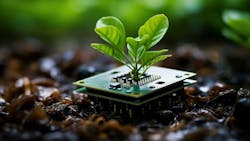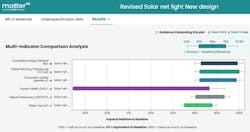Baking Sustainability into the Future of Electronics
What you’ll learn:
- Sustainability is becoming an increasingly important issue within the electronics industry.
- Lifecycle assessment (LCA) tools can help companies address these issues by identifying and extracting sustainability-related information from design and planning workflows and using it to create actionable information.
- Most sustainability practices, when properly implemented, also help companies improve their productivity and profitability.
While sustainability is becoming a bigger issue within the electronics industry, many misconceptions still exist about what defines sustainable design, manufacturing, and supply-chain practices. On top of that, questions abound about how best to implement them in a practical and cost-effective way. This can be challenging since the concept of “sustainability” embraces such a wide range of interrelated factors that reach across a product’s entire value chain.
The latest lifecycle assessment (LCA) software tools are potential mitigators for these problems. They enable designers and tech managers to extract critical data from design and planning workflows and turn it into actionable information.
Lee Goldberg, a contributing editor at Electronic Design, explored many of these issues and potential solutions in a recent chat with Lise Lauren, founder and CEO of Earthshift Global. The company is on the front lines of LCA software tool development as well as consulting services on how to use and understand what they’re telling you. One of the important takeaways was that most sustainability practices, when properly implemented, also help companies improve their productivity and profitability.
This interview has been lightly edited for clarity.
Electronic Design: What is “design for sustainability”? How much of a difference can it actually make in the electronics industry?
Lise Lauren: In some ways, designing a product to be sustainable is just good engineering—minimizing the amount of material used, maximizing its operating efficiency, adopting clean production processes. Product designers have always pursued these types of goals.
Lately, we’re seeing that many opportunities for impact reduction can be uncovered early in the design process by looking at a product’s lifecycle. Where do the materials and resources come from? How does the product provide the desired function? What happens at the end of its life (EOL)?
This approach to design reveals environmental “hot spots”—sometimes unexpected or counterintuitive—that can be addressed relatively easily at that stage to provide significant impact reductions during and after a product’s useful life. That’s what we mean by design for sustainability (DfS).
Can you give me an example? How have you put this into practice?
Yes, I can. My team looked at a charger for consumer electronics that, as it turns out, had already shown significant advantages over others on the market. We were working with a chip designer that had secured a design win in the device. While they weren’t surprised that the largest impact came from the use phase, they were surprised that, for most users, the biggest contributor to its environmental impact was energy consumed when the charger was left plugged in after charging was completed.
While the chip designer couldn’t directly address this issue, they were able to convey this information to the company that makes the charger. We uncovered that reducing the power consumption after the charging process ended had the potential to reduce the environmental impact of the device by between 15% and 25% depending on the region, while also reducing energy costs for the end-user.
The concept of lifecycle assessment (LCA) has been around since the 1990s. If the opportunities are so great, why hasn’t the design community already taken up this approach more broadly?
I have been in the sustainability field almost that long myself, after starting my career in semiconductor manufacturing. I’m confident that the biggest reason is related to the nature of the LCA software tools on the market. They’re designed for specialists, which makes them complex and challenging to learn.
But even more important from a design perspective is that they require extensive data about product details — exactly what type of metal or plastic is used for a component, where manufacturing will take place, what the supply chain will look like—which simply doesn’t exist in preliminary design phases.
The LCA software industry’s focus on deep, detailed assessment has been empowering in many situations, but it’s a poor match for the design environment where many variables are being considered under heavy time pressure. So, early-stage modeling and assessment have been constrained.
That’s unfortunate, because those preliminary design phases offer the greatest opportunity for product improvement at the lowest cost, with up to 80% of impacts fixed in the concept-creation stage. As a result, we’re facing something that’s been referred to as the "eco-design paradox.” There is this highly flexible period early on when design decisions are still fluid, but it’s difficult to assess the impacts with LCA tools that are not equipped to handle uncertain inputs.
So, you have been tracking this problem for a long time. Can you tell me more about your approach to solving that paradox?
This has been a years-long effort for us. It involves implementing advanced algorithms developed at MIT and Arizona State University into an easy-to-use interface that resonates with product designers. Through our work with researchers at Dartmouth College and the Delft University of Technology, we’ve found that the way forward is with what I would call a lightweight tool that can handle uncertainty, quickly uncover hot spots, and present the results in a way that’s easily understood by designers and others in the decision-making process. Our implementation is called Matter PD, with the “PD” standing for Product Design.
One key element is what we call “underspecification.” In other words, we use very broad-strokes categories like “metal” or “plastic” for product components rather than detailed specifications. When that more-general information is combined with techniques like Monte Carlo analysis that can quickly model thousands of scenarios, critical areas of concern can be uncovered very rapidly, revealing the most pressing issues.
This streamlined model-making for impacts allows the designer to get results in hours rather than weeks. Since choosing data is itself a tricky task, underspecification makes it easier to pick a few likely candidates and refine only as needed.
Perhaps the biggest benefit of underspecification and the extensive ability to identify uncertainties in an early design is that it highlights what doesn’t make a difference. If it doesn’t matter what plastic you use in your design or how big a heatsink you need, you can refocus your efforts and design criteria on the meaningful decisions.
The findings must be easily conveyed to people in management, manufacturing, procurement, marketing, and other disciplines, because they all play a role in addressing the issues. In many cases, results aren’t easy to interpret—one option may be better in water scarcity, for example, but worse in ecosystem quality. We’ve included a scientifically robust system of “one-score” metrics, with quantified uncertainty, that is understandable to anyone. What’s important is that you don’t need formal training in environmental sciences.
Can you say a little more about what design for sustainability will look like in practice for electronic products?
The presence of silicon and software in so many products opens up big opportunities for impact reduction thanks to their flexibility. To return to what we were talking about with the charger: idle power reduction can be achieved through better software design.
But if you want to take it a step further, maybe you reduce overall power consumption by consolidating functions into a single SoC. That change also has the potential to reduce the material impacts. At the same time, you can use quick non-technical fixes—for instance, a label on the charger that reads, “Unplug when charging is complete.”
Similarly, when HP was developing its 3D-printing technology, they looked at their experience with inkjet printers and assumed energy use would not be a big factor. But early studies found that the 3D process used lots of energy, so the R&D team looked at different ways to reduce energy consumption.
Supply-chain and production-process adjustments also come into play. Many electronic products rely on air freight. When people see that as a hot spot, they are almost always surprised. Of course, some products need to be expedited, but switching to sea or land freight for the rest often brings a measurable footprint reduction. In other cases, selection of a supplier that uses renewable energy or provides reused or recycled material can further reduce impacts.
This illustrates why it’s so important for early-stage LCA findings to be shareable across an entire organization. That way, they can be addressed in a coordinated, strategic way with everyone having a clear sense of the issues and the goal.
Product designers already face so many challenges. Why should we add sustainability to the list of requirements they face?
It’s a challenge, but product designers are experts at juggling competing priorities. From where I stand, I don’t think one more or one less is going to make that much of a difference. Also, from what I’ve seen, the expectation is already there, and pressure on product designers is mounting.
Around the world, governments are trying to address climate change and other environmental issues, and there’s growing regulatory impetus for sustainable design, as well as shareholder pressure. Companies of all sizes are positioning themselves for that.
There are market forces driving products designers to be more sustainable, too. A recent sustainability survey from Bain found that more than a third of business-to-business buyers would change suppliers today if they found out their sustainability needs were not being met, and 57% expect to change suppliers in the next three years for that reason.
In a separate survey, Bain also uncovered that consumers worldwide would pay a 12% premium for sustainable products. And for the last several years, its surveys have found that 60% of consumers have had their climate concerns intensify in the preceding 24 months.
So, it all comes down to giving product design teams better tools to help them meet the expectations they’re already facing. It’s also worth noting that we’ve seen many cases where the tenets of design for sustainability can make products more affordable by reducing their energy usage or making them less expensive to transport.
About the Author
Lee Goldberg
Contributing Editor
Lee Goldberg is a self-identified “Recovering Engineer,” Maker/Hacker, Green-Tech Maven, Aviator, Gadfly, and Geek Dad. He spent the first 18 years of his career helping design microprocessors, embedded systems, renewable energy applications, and the occasional interplanetary spacecraft. After trading his ‘scope and soldering iron for a keyboard and a second career as a tech journalist, he’s spent the next two decades at several print and online engineering publications.
Lee’s current focus is power electronics, especially the technologies involved with energy efficiency, energy management, and renewable energy. This dovetails with his coverage of sustainable technologies and various environmental and social issues within the engineering community that he began in 1996. Lee also covers 3D printers, open-source hardware, and other Maker/Hacker technologies.
Lee holds a BSEE in Electrical Engineering from Thomas Edison College, and participated in a colloquium on technology, society, and the environment at Goddard College’s Institute for Social Ecology. His book, “Green Electronics/Green Bottom Line - A Commonsense Guide To Environmentally Responsible Engineering and Management,” was published by Newnes Press.
Lee, his wife Catherine, and his daughter Anwyn currently reside in the outskirts of Princeton N.J., where they masquerade as a typical suburban family.
Lee also writes the regular PowerBites series.



